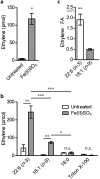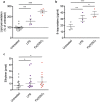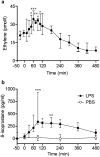Ethylene, an early marker of systemic inflammation in humans
- PMID: 28761087
- PMCID: PMC5537290
- DOI: 10.1038/s41598-017-05930-9
Ethylene, an early marker of systemic inflammation in humans
Abstract
Ethylene is a major plant hormone mediating developmental processes and stress responses to stimuli such as infection. We show here that ethylene is also produced during systemic inflammation in humans and is released in exhaled breath. Traces of ethylene were detected by laser spectroscopy both in vitro in isolated blood leukocytes exposed to bacterial lipopolysaccharide (LPS) as well as in vivo following LPS administration in healthy volunteers. Exposure to LPS triggers formation of ethylene as a product of lipid peroxidation induced by the respiratory burst. In humans, ethylene was detected prior to the increase of blood levels of inflammatory cytokines and stress-related hormones. Our results highlight that ethylene release is an early and integral component of in vivo lipid peroxidation with important clinical implications as a breath biomarker of bacterial infection.
Conflict of interest statement
The authors declare that they have no competing interests.
Figures




References
-
- Abeles, F. B., Morgan, P. W. & Saltveit, M. E. Ethylene in Plant Biology. Ethylene in Plant Biology doi:10.1016/B978-0-08-091628-6.50015-1 (1992).
-
- Gane R. Production of Ethylene by Some Ripening Fruits. Nature. 1934;134:1008–1008. doi: 10.1038/1341008a0. - DOI
-
- Yang SF, Hoffman NE. Ethylene Biosynthesis and its Regulation in Higher Plants. Annu. Rev. Plant Physiol. 1984;35:155–189. doi: 10.1146/annurev.pp.35.060184.001103. - DOI
Publication types
MeSH terms
Substances
Grants and funding
LinkOut - more resources
Full Text Sources
Other Literature Sources

